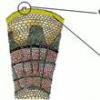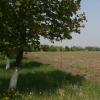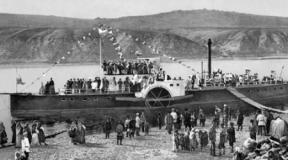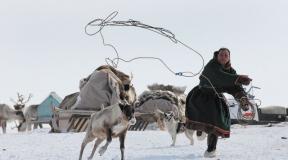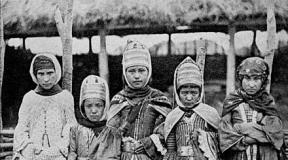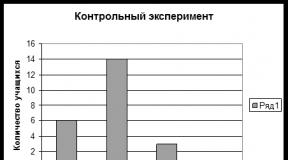Sacred grove or Khetag bush. Khetag Grove. The legend of the creation of one of the main Ossetian sanctuaries - Why is it important
The logic of the content of the “legend about Khetag” and Kosta Khetagurov’s poem “Khetag”gives us the opportunity to assert that the holy grove of Khetag is purely Orthodox, Christian. This is also confirmed by the fact that initially there was a church in the grove, on the top of which there was a large wooden cross, and inside the grove there was a healing spring. The elders of the village of Kadgaron said: “ Tsomut dzuary bynmzh", i.e. let's go to the cross.
If we turn to the works of Kosta Khetagurov about Khetag, it is not difficult to understand that Khetag himself was a zealous Christian. This means that the grove named after him must be Christian.
In Volume I on page 271 Costa writes:
... Khetag was sent to Crimea by his parents, -
He was apprenticed to a Greek monk,
And about the laws of harsh religion
He himself told me with enthusiasm.
It was as if he saw Christ with his own eyes,
I saw his miracle of Resurrection,
He read books, listened to preachers...
With someone else's faith he returned from there...
Having converted to Christianity, Khetag fled from the persecution of his brothers to Mountain Ossetia.”
It must be assumed that Khetag knew for sure that Ossetia and the Ossetians are Christians. After all, he fled from his siblings and his beloved, because they were Muslims and categorically demanded that Khetag renounce Orthodoxy, which he did not do, for which they persecuted him to kill him.
Apart from meager tradition, no one can say when this miracle of God happened. Human memory is a great gift from God, which preserves the main events that take place. Nevertheless, human memory is not capable of retaining the smallest details for centuries and millennia. That is why people treat the distant past as a legend and tradition. Only a certain part of a legend or tradition is true.
But over time, part of this truth is forgotten, and the rest is overgrown with fables and the fruits of human imagination. This makes it difficult to determine what is fact and what is fiction.
This is what happened with the legend about the Khetag grove and the history of him. Miracles do not happen spontaneously, out of nothing. The miracle that happened for the sake of saving the zealous Khetag, when a whole grove rose up, came off the ground and covered the fleeing Christian - in fact, a great miracle of God, for which nothing is impossible.
There are several legends about the Khetag grove and about him. Each author rewrites this story in his own way, which misleads people.
Therefore, the date for celebrating Khetag Day is confused, which is very sad.
When, after all, should it be celebrated? For a correct understanding of this, let me remind you of the interview of the rector of the Church of the Nativity of the Blessed Virgin Mary, Archpriest Konstantin Dzhioev, to the newspaper “North Ossetia” dated September 7, 2002:
“... Let me remind you about one more holiday - Khetag Day. Now it is celebrated on the second Sunday of July, and Christians fast at this time, and our ancestors, I am sure, could not celebrate and make sacrifices during fasting. This year, thank God, Khetag Day did not coincide with fasting, but most often it will coincide. But back in the 19th century, K. Khetagurov wrote that Khetag Day one year fell on July 5, but many do not take into account that we are talking about the old style, and if you add 13 to 5, you get the 18th number, and 18 It's already the third Sunday in July. This means that it is correct to celebrate Khetag Day on the Sunday when the fast ends. After all, Khetag Day is not a pagan holiday, but an Orthodox one... And it is more correct to celebrate, I think, not the day of the saved Khetag, but the holiday of St. George the Victorious, who performed a miracle and saved Khetag.”
I will add from myself. In the interview, the conversation is about the Peter the Great Fast, which ends on July 11 inclusive, and the Feast of Peter and Paul falls on July 12. If you celebrate it on the third Sunday in July, there will never be a coincidence with fasting. But over the course of 14 years, the second Sunday of July falls during Lent 10 times and only 4 times outside Lent.
For clarity, it should be noted that of the 86 known folk holidays in Ossetia, more than 40 are undoubtedly purely Orthodox. History says that our ancestors, the Ossetian Alans, were mostly Orthodox Christians. Despite the fact that there are many opponents of Christianity, there are much more zealous, true Christians.
In the year of the formation of “Styr Nykhasa”, a spontaneous decision was made at the government level to hold the Khetag Day holiday on the second Sunday of July. An in-depth analysis was not made, a number of factors that at first glance seemed insignificant were not taken into account.
FirstlyAccording to Ossetian belief, the number 2 refers to memorial occasions, in contrast to the number 3, which refers to joyful events.
Secondly, when Khetag Day is celebrated on the second Sunday of July, in most cases this day coincides with the last days of Peter's Lent, and our ancestors never held holidays during Lent - this is a sin! And as a consequence of this sin - God's punishment - tragic and accidents with human victims: it is enough to turn to the events of recent years to be convinced of this.
To believe in it or not to believe is everyone's business. Perhaps these are accidents, but I attribute such tragedies to the fact that the Khetag holiday is held during fasting, and the Lord does not forgive us for this. We consciously commit this sin before the Lord God because of our lack of spirituality and immorality.
Therefore, I express the opinion of many people and make a proposal to amend the government decree: Khetag Day should be held annually on the third Sunday of July. Then the holiday will never coincide with fasting. Such a decision would be reasonable and sinless.
Vladimir KHORANOV,
resident of Yuzhny village,
long-time reader of "PO".
Khetag Grove (Russia) - description, history, location. Exact address and website. Tourist reviews, photos and videos.
- Last minute tours in Russia
Khetag Grove is a sacred place for Ossetians, the appearance of which is associated with an ancient legend. It says that the Christian Kabardian Khetag, who refused to convert to Islam, fled to Ossetia, but he did not have the strength to get to the forest and hide there. And then the forest itself came to the fugitive, hiding him from his pursuers.
Since then, Christians from all surrounding towns and villages have come here to pray. Prayers read in the grove are considered especially powerful. Since 1994, the Khetag holiday has been celebrated here in July, for which many Ossetians gather. It falls on the second Sunday of the month.
Now, as before, the Khetag grove has an almost perfectly round shape, for which it is often called “Round”. The total area of the relict forest is 13 hectares. There is a prayer house here, and special places for offerings (traditionally these are warm pies).
If you look south, at the top of the mountain slope you can see a clearing that matches the shape and size of the grove. It seems that the trees have actually moved to the right place in full.
The trees in the grove are taller and more branched than in all the surrounding forests. Perhaps this is due to the fact that taking anything out of the forest, much less breaking branches, is prohibited. Also, you can’t light a fire, drink alcohol, or shed blood here.
Practical information
Address: North Ossetia, Alagirsky district, village. Suadag. GPS coordinates: 43.057816; 44.301795.
Hundreds of holidays are celebrated annually in our country, the existence of which most Russians have never even heard of.
In various gorges, and often in villages North Ossetia They celebrate many holidays that are different from each other in either content or form. It’s impossible to describe them all, but Ossetians also have the most important celebrations for the entire people. For centuries they were preserved in their original form with their national names and customs: Dzheorguyba, Uatsilla, Kakhts, Bynaty hitsau and many others.
Ossetians celebrate the holiday in July Khetaji Bon- translated into Russian Khetag Day.
Legend says that Kabardian Prince Khetag fled from his pursuers who intended to kill him for converting to Christianity. As you know, Kabardians, like most of the Caucasians, are Muslims. The only Christian republic in the Caucasus – Ossetia. Khetag fled there. When the pursuers had almost overtaken the young man in an open field, he prayed:
O Uastirdzhi! (in Ossetian this means “Oh, Lord”) Help me!
Khetag! Run to the forest!
Forest to Khetag!
And a wonderful grove with tall trees grew in front of him. There the young man took refuge and thus escaped from his pursuers: they turned back because they could not find Khetag. The young prince lived in the grove for about a year, after which he moved to the Ossetian mountain village of Nar, where he gave rise to the famous Ossetian family Khetagurovs.
Khetag Grove is located east of the village of Suadag in North Ossetia. Now this is a holy place. Every year on the second Sunday of July, people from all over North Ossetia come here to pray to the Almighty for help. They say that prayers said in the Holy Grove of Khetag have special power. It is believed that Khetag patronizes all people: even those who have committed crimes can pray in the grove. The main thing is not to harm her.
In recent decades, the holiday has become truly national. On Khetag Day, a bull, a calf or a ram is sacrificed. Those who, for objective reasons, cannot do this, buy three ribs.
As on other major Ossetian holidays - Uatsilla, Dzheorguba, etc. - on this day it is not customary to put poultry, fish, pork and dishes prepared from them on the table.
You should come to the grove with three pies and meat. But you’re not supposed to have endless feasts there.
There are many traditions and prohibitions associated with the Khetag grove: for example, nothing should be taken out of the grove. In ancient times, only the most worthy men of the village were allowed there in order to ask for a harvest, a cure for an illness, and other essential needs. Before the Great Patriotic War, women were prohibited from entering the grove, but during the war years they began to come there to pray for their loved ones who had gone to war. Since then, the ban has been naturally lifted.
Nowadays, the Khetag Grove does not have state status as a natural or cultural monument. This is a national shrine, protected and revered by the Ossetian people.
Elina Khetagurova
The Khetag Grove is a preserved area of almost perfectly round forest, with an area of about 13 hectares, in the Alagirsky district of North Ossetia near the Vladikavkaz-Alagir highway. If you move from Vladikavkaz to the west, on the way to the Alagir Gorge, on the right hand of the road there will be a small grove, and next to it there will be a covered pavilion, which from a distance looks like a bus stop.
In the center of the pavilion there is a colorful panel - a gray-haired old man soaring over the mountains astride a winged horse. The Ossetian elder is called Uastirdzhi, in the Christian tradition - Saint George, the most revered saint in Ossetia.
2.

Ossetians revere the Grove as a sacred place. Every year on the second Sunday of July, people from all over the republic, as well as from neighboring South Ossetia, come here for the Khetag holiday.
3.
Each Ossetian village has its own place for celebration in Roshcha. Metal boxes are installed everywhere here, where believers place monetary donations.
4.
A trench was built on the eastern edge of the grove A ndon - house of worship. Women can only go there on holidays.
5.
According to legend, Khetag was a Christian, the son of a Kabardian prince, who refused to convert to Islam. His relatives were angry with him for this, and he decided to hide in Ossetia. According to another version, Khetag fled from his native place with a stolen bride.
On the way to the Kurtatin Gorge, near the modern village of Suadag, Khetag’s pursuers began to overtake. Then from the thicket the fugitive heard a call: “Khetag! Into the forest, into the forest!” But he would not have had time to reach the forest. And then the fugitive said: “Let the forest come to Khetag!” - and he was surrounded by a thick thicket. The pursuers turned back because they could not find Khetag.
He lived in the grove for about a year, and then moved to the mountain village of Nar, where he gave rise to the famous Khetagurov family. The most famous representative of this family is the founder of Ossetian literature Kosta Khetagurov.
6.
According to legend, Saint George appeared in the Khetagu Grove.
7.
People from all corners of the two-united Ossetia come here to pray to the Almighty for help. They say that prayers said in the sacred grove have special power. The main thing is not to harm her.
8.
There are many traditions associated with the Khetag Grove: for example, nothing can be taken from here, not even acorns. For disobedience, Khetag severely punishes anyone who violates the ban. They don’t take out dead trees either, they just put the dead trunks aside.
Candles are placed in the wooden figure (to the right of the table) during the holiday.
Photo: welran .
9.
In ancient times, only the most worthy men were allowed into the Grove to ask God and Uastirdzhi for a harvest, a cure for illness, etc.
Photo: welran .
10.
Even in the first decades of the last century, women were not allowed to enter the Grove, but during the Great Patriotic War they began to come here to pray for the fighting men. Since then, this ban has naturally disappeared.
11.
Photo: welran
.
12.
Most Ossetians are Orthodox Christians, but their Orthodox tradition is intertwined with national traditions. Thus, Ossetians honor Saint George the Victorious (Uastirdzhi). In the popular consciousness, his image combines the features of an Orthodox martyr and a hero from the pagan pantheon.
Photo: welran .
13.
In the Grove there is a stone table for three pies - an attribute of any Ossetian prayer-feast. The pies brought here must be warm, since, according to legend, a person’s good intentions are absorbed into them when cooked. And in warm pies these intentions are preserved better.
14.
In addition to pies, homemade beer and araka are brought to the Grove during the festivities.
15.
The grove does not have any state status. This is not a natural or cultural monument - it is a national shrine. Since 1994, Khetag Day has been celebrated in North Ossetia as a national holiday.
In the vastness of North Ossetia there is a sacred place called the Khetag Grove. All Ossetians know the legend about it, since it has been passed from fathers to children for several hundred years. It is difficult to say how true this story is, but everyone should hear it. After all, such a wondrous miracle has not happened on Orthodox soil for a long time.
Grove of Khetag: the legend of a man of unshakable faith
A long time ago, a tribe of Alans lived near the Bolshoi Zelenchuk River. They were ruled by Prince Inal, a strict but fair man. He had three sons: Beslan, Aslanbeg and Khetag. Since childhood, the brothers competed with each other, because each wanted to become a real man in the eyes of their father. But even so, they never crossed the line, remaining true brothers.
Alas, peace did not last long in this land. A new religion came to them from neighboring lands - Islam. And the people quickly forgot about the Orthodox faith, choosing a different path for themselves. And only Khetag remained faithful to previous traditions, not wanting to recognize another teaching. Moreover, he tried to reason with his people, but they only became angry with him.
Seeing the indignation of the people, Inal drove his son from his land, ordering him not to appear before him again. As for the brothers, they supported their father and soon forgot about the existence of Khetag. After this, the young man could no longer stay in his native land and finally decided to leave it.

The phenomenon of the miracle of Khetagu
The hearts of his enemies were restless, and they decided to kill the selfless Christian in order to glorify Allah. They quickly caught up with Khetag, since he was unaware of the approaching threat. But it was not so easy to stop the young warrior, especially on a faithful horse.
Seeing the enemies superior in strength, Khetag rushed to the nearest forest. Only there could he cope with them, attacking them one by one. Alas, there were still trees far away, and the riders were already approaching him closely. A little more - and he would have been surrounded, and then even the skill of a warrior would not have saved him.
And then a voice was heard from the forest: “Here, Khetag, quickly come here!” The young man did not see who was calling him, but he sensed wondrous power in that voice. Then Khetag shouted at the top of his voice: “If I don’t make it to the forest in time, then let him come to me!” The forest obeyed him, and in an instant the Khetag grove was surrounded by an impenetrable wall of trees. The enemies of the wondrous miracle were frightened, turned around and ran away.

Mysterious savior
The young man looked around, realized that there was no more pursuit, and began to look for his savior. And then the great Uastirdzhi (better known as Saint George) appeared to his eyes, all dressed in a bright stream of light. And he said in a quiet voice: “Your salvation is the reward for your faith, so remember this and continue to bring the word of God to the people.”
Khetag lived in the forest for another year in order to comprehend the great truth. Then he collected his things and went to the village of Nar. Over the years, the young man grew even stronger and became a worthy husband, and brought into the world a great offspring, known as the Khetagurov family.

Memory of a great hero
The history of the Khetag grove has become a symbol of the true faith of the Ossetian people. That is why it has long been customary to pass it on from father to son, so that the memory of the great hero lives forever. In addition, the Khetag grove has become a place of pilgrimage, where believers from all over Ossetia come.
People believe that St. Uastirdzhi even today protects peace in this forest. Therefore, all pilgrims honor the customs and laws that the Khetag grove preserves. Legend has it that the main rule is the integrity of the entire array. That is, you cannot break anything in the forest, much less take it out of it: be it a dry branch or a small acorn.
Also, for a long time, the Khetag grove was closed to women. However, during the Second World War, saddened wives came here to ask St. George for protection. Since then the law has softened towards them. Now they can come here during the holidays to thank Uastirdzhi for his patronage.

What is Khetag Grove really like?
Even without legends, this place has a special charm that is unique to it. What is most surprising is that the grove has an almost perfect round shape. Looking at her, you involuntarily begin to believe that she, indeed, appeared thanks to divine influence.
It is also impossible not to admire how the Khetag grove has changed under the influence of time. North Ossetia did everything possible to transform its shrine without disturbing its peace. Thus, centuries-old ash and beech trees harmoniously combine with stone tables for sacred meals, and small benches placed along the paths only decorate the local landscape.
And although the territory of the grove is not included in the protected areas of North Ossetia, people treat it with all respect. There is no place for poaching, vandalism or other outrages, which only confirms how spiritual the Ossetian people can be.



